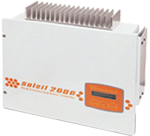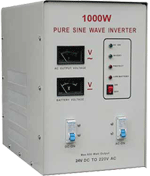Inverters for Grid-Tie & Off-Grid Solar Power
Grid-tie Solar System Inverters
Solar residential and commercial inverters from Enphase , SMA Sunny Boy , Fronius , SolarEdge , PV Powered , Solaron, Advanced Energy, Solectria, and Outback. We carry inverters for residential solar systems and off-grid solar systems.
Compare and review these grid-tie inverters. Contact us for today's low wholesale discount price or view our low solar system prices.
Sunny Boy SE
These hybrid 3.8 kW to 7.7 kW inverters combine PV and battery inverter functions in one unit:
3.8-US-50,
4.8-US-50,
5.8-US-50, 7.7-US-50,
Sunny Tripower X-US & Core1 Commercial Inverters
The Sunny Tripower X, available in power classes from 20 to 30 kW, excels in rooftop and ground-mounted installations.
20-US-50,
25-US-50,
30-US-50,
The Sunny Tripower CORE1, offers models ranging from 33 to 62 kW & revolutionizes large-scale commercial installations with its unique free-standing design.
Core1 33-US-41,
Core1 50-US-41,
Core1 62-US-41.
Discontinued SMA Inverters:
Sunny IslandGrid-connected and off-grid battery backup inverter.
Sunny Island Multicluster
Connect up to 36 Sunny Islands and a diesel genset for 208 VAC 3-phase power!
Sunny Island Smartformer
Split-phase stand-alone grids—now easier than ever.
Sunny Tower
Fronius
Fronius IG, IG Plus V, IG Plus Advanced,
Galvo, Fronius CL
inverters
IG Series: IG 2000, IG 2500 LV,
IG 3000, IG 4000, IG 4500 LV,
IG 5100
IG Plus V Series: IG Plus
V
3.0-1
UNI, IG
Plus V
3.8-1 UNI, IG
Plus V 5.0-1 UNI, IG
Plus V
6.0-1 UNI, IG Plus
V
7.5-1
UNI, IG
Plus V 10.0-1 UNI, IG
Plus
V
11.4-1 UNI , IG
Plus
V
10.0-3 Delta, IG
Plus V 11.4-3 Delta, IG
Plus
V
12.0-3 WYE277
IG Plus Advanced Series w/ AFCI: IG
Plus Advanced 3.0-1 UNI, IG
Plus Advanced 3.8-1 UNI, IG
Plus Advanced 5.0-1 UNI, IG
Plus
Advanced 6.0-1 UNI, IG
Plus Advanced 7.5-1 UNI, IG
Plus Advanced 10.0-1 UNI, IG
Plus
Advanced 11.4-1 UNI, IG
Plus Advanced 10.0-3 Delta, IG
Plus Advanced 11.4-3 Delta, IG
Plus Advanced 12.0-3 WYE277.
Galvo compact residential solar inverters: Galvo
1.5-1, Galvo
2.0-1, Galvo
2.5-1
and Galvo
3.1-1.
Fronius CL Series commercial
inverters: CL
33.3
Delta, CL
36.0
WYE277, CL 44.4
Delta, CL
48.0
WYE277, CL 55.5
Delta and CL
60.0 WYE277.
Sol-Ark Hybrid Inverters
All-in-one hybrid inverters for residential and commercial applications. Grid-tie with battery backup functionality. High efficiency, transformerless design.
Residential models:
- 8K-2P-N: 8kW output, 11kW max PV input, 48V battery
- 8K-2P-EMP: 8kW output, 11kW max PV input, 48V battery, EMP hardened
- 12K-2P-N: 12kW output, 13kW max PV input, 48V battery
- 12K-2P-EMP: 12kW output, 13kW max PV input, 48V battery, EMP hardened
- 15K-2P-N: 15kW output, 19.5kW max PV input, 48V battery
- 15K-2P-EMP: 15kW output, 19.5kW max PV input, 48V battery, EMP hardened
Commercial models:
- 30K-3P-208V: 30kW output, 39kW max PV input, high voltage battery
- 60K-3P-480V: 60kW output, 78kW max PV input, high voltage battery
SolarEdge
The benefits of a micro-inverter using revolutionary SolarEdge
"power optimizers". Benefits include: shade tolerance, safe installation and low voltage
DC.
The
highest efficiency grid-tie inverter system available!
SolarEdge inverter models include: Single-Phase: SE3000A-US
· SE3800A-US
· SE5000A-US
· SE6000A-US
· SE7000A-US
| Three-Phase: SE9KUS
· SE10KUS
· SE20KUS
Solaron
Commercial grade American made inverters for rooftop installation. Manufactured by Advanced
Energy.
Models include Solaron250
kW and Solaron
333 kW.
Enphase
This grid-tie microinverter has the unique advantage of using one inverter per solar
panel
so
you
can place modules on multiple roof faces, great for systems with shade problems.
Schneider Electric Conext
XW
Solar Battery Back-up Inverters for Grid-Tie and Off-Grid Solar Systems include the XW5548
& XW6848
Solar System Inverters
Inverters for centralized solar power plants.
Tripower 60-US
This inverter is for large commercial solar power plants has a maximum output of 60,000
watts.
42 Sunny
Tripower 60-US inverters can be combined into one centralized solar system.
Off-Grid Inverters
(Used in our SES Complete Off-Grid Remote Industrial Solar Systems)
Outback FX Series
The FX2024 and FX2548 are 2000W rugged inverter/ charger
units
that
are designed to withstand all types of weather and temperatures.
Morningstar SureSine
A compact sinewave inverter for remote applications including SCADA, Wi-Fi, telecom, radio,
remote
cabins, small computers, RVs and other applications not requiring large load requirements.
Types of Inverters
Stand-alone Inverters
Stand-alone Inverters convert DC power stored in batteries to AC power that can be used as needed. Selecting an inverter for your power system based on the maximum load you will be powering, the maximum surge required, output voltage required, input battery voltage and optional features needed. High quality stand-alone inverters are available in sizes from 100 watts, for powering notebook computers and fax machines from your car, to 500,000 watts, for powering a commercial operation. The size of an inverter is measured by its maximum continuous output in watts. This rating must be larger than the total wattage of all of the AC loads you plan to run at one time. The size of the inverter can be minimized if the number and size of the AC loads is kept under control. Wattage of most AC loads can be determined from a tag or label on the appliance, usually located near where the power cord enters, or from the owner's manual. If the inverter is expected to run induction motors, like the ones found in automatic washers, dryers, dishwashers and large power tools, it must be designed to surge, or deliver power many time sits rating for short periods of time while these motors start.
Stand-alone inverters are available with three basic power output waveforms: square wave, modified square wave (often called modified sine wave) and sine wave. Intertie inverters and utility companies deliver a sine wave. Square wave inverters have the lowest cost and efficiency and are not sold in this catalog. The price of the better quality inverters is low enough to make square wave inverters an unattractive choice.

Trace UX series, DR series, U series inverters and Genius inverters have modified square wave output with harmonic distortion of around 40%. They are an economical choice in power systems where waveform is not critical. Their high surge capacity allows them to start large motors while their high efficiency makes them economical with power when running small loads like a stereo or a small light. They can power most lighting, televisions, appliances and computers very well. We do not recommend them for computer systems with laser printers.
Unfortunately, this type of inverter may destroy some low cost rechargeable tools and flashlights, and their waveform will not allow many laser printers, copiers, light dimmers and some variable speed tools to operate. Equipment with silicon controlled rectifiers or SCRs will not operate. Some audio equipment will have a background buzz that may be annoying to music connoisseurs.
Sine wave inverters have a slightly higher cost, but they can operate almost anything that can be operated on utility power. Trace Sinewave inverters are available in sizes from 2500 watts to 5500 watts, and a pair of them can be synchronized to deliver up to 11,000 watts. They are an excellent choice for a 'whole house" inverter. Exeltech sinewave inverters, available in sizes from 150 watts to 5000 watts, are an excellent choice for power systems running audio or telecommunications equipment and other electronics that are waveform-sensitive. Larger Sinewave inverters are available in sizes up to 500,000 watts that can run a small village.
Intertie Inverters
Intertie Inverters change DC power into AC power to be fed into the utility grid. A power system with this type of inverter uses the utility company as a storage battery. When the sun is shining, your electricity comes from the PV array, via the inverter. If the PV array is making more power than you are using, the excess is sold to the utility (power company) through an electric meter. If you use more power than the PV array can supply, the utility makes up the difference. This type of system makes the most sense if you have utility power, because there are no batteries to maintain or replace, but it has a very long payback period and may not be cost-effective at today's electric rates. The Trace SWPV, UT and microsine, AEI GC and Omnion 2400 inverters are examples of an intertie inverter. Using a multifunction inverter allows you to sell excess power to the utility, and also maintain a battery bank for standby power in the event of a utility power failure.

Multifunction Inverters
Trace Engineering Company produces a line of sine wave inverters called the SW line that can operate as a stand-alone inverter and as an intertie inverter at the same time. In a typical installation, the Trace SW inverter is connected to a battery bank, the utility power lines, a standby generator and the house load center. When batteries are in a charged condition, the SW inverter supplies AC power to the house from the batteries. If the batteries become discharged, the inverter supplies the house loads from the utility lines, while charging the batteries. If the batteries become fully charged by another power source, such as photovoltaic modules or a wind or hydroelectric generator, excess power may be sold back to the utility. If utility power fails, the inverter can still operate, supplying critical loads. If a standby generator is started, it can also supply power to loads. The inverter will synchronize to the generator and allow loads to be powered that are too large for either the generator or inverter to supply alone. Multifunction inverters are not the most efficient intertie inverters because the system must have a battery, but they allow system flexibility that intertie inverters do not.

Other Inverter Information
Output Voltage
We sell inverters that supply standard 120 Volt 60 HZ AC power, such as one gets from utility companies and fuel-powered generators. Most of them can be special ordered with other output voltages and frequencies for use anywhere in the world. Please contact us with any special requirements that you have.
Interference
The electronic circuitry in inverters may, in some cases, cause problems with radio and television reception, noise on telephones and buzz in audio equipment. Sine wave inverters cause the least amount of interference. Interference can be minimized by locating the inverter very close to the batteries, twisting together the cables that connect the inverter to the battery, running AC lines separate from other wiring(such as telephone wires) and locating the inverter away from appliances that are susceptible to interference. Most inverters can cause interference on AM radio!












